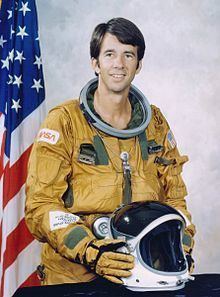Nationality American Name William Lenoir Time in space 5d 02h 14m | Other occupation Engineer Status Deceased Role Engineer | |
 | ||
Other names William Benjamin Lenoir Similar People Joseph P Allen, Vance D Brand, Robert F Overmyer | ||
William Benjamin "Bill" Lenoir, Ph.D. (March 14, 1939 – August 26, 2010) was an American electrical engineer and a NASA astronaut.
Contents
- Early life and education
- Personal life
- NASA career
- Spaceflight experience
- Death
- Organizations
- Honors and awards
- Physical description
- References
Early life and education
Lenoir was born on March 14, 1939, in Miami, Florida. He attended primary and secondary schools in Coral Gables, Florida; he graduated from Coral Gables Senior High School in 1957. He graduated with a Bachelor of Science degree in Electrical Engineering from the Massachusetts Institute of Technology in 1961, where he was an active member of Sigma Alpha Epsilon (SAE). Lenoir continued at MIT, earning a Master of Science degree in 1962, and a Doctor of Philosophy degree in EECS in 1965.
From 1964 to 1965, Lenoir was an instructor at MIT; and in 1965, he was named assistant professor of Electrical Engineering. His work at MIT included teaching electromagnetic theory and systems theory, as well as performing research in remote sensing. He was an investigator in several satellite experiments and continued research in this area while fulfilling his astronaut assignments.
Personal life
Lenoir was divorced and remarried, and had three children.
Lenoir logged over 3,000 hours of flying time in jet aircraft.
NASA career
Lenoir was selected as a scientist-astronaut by NASA in August 1967. He completed the initial academic training and a 53-week course in flight training at Laughlin Air Force Base, Texas.
Lenoir was backup science pilot for Skylab 3 and Skylab 4, the second and third manned missions in the Skylab program. During Skylab 4, he was co-leader of the visual observations project and coordinator between the flight crew and the principal investigators for the solar science experiments.
From September 1974 to July 1976, Lenoir spent approximately one-half of his time as leader of the NASA Satellite Power Team. This team was formed to investigate the potential of large-scale satellite power systems for terrestrial utility consumption and to make program recommendations to NASA Headquarters. Lenoir supported the Space Shuttle program in the areas of orbit operations, training, extravehicular activity, and payload deployment and retrieval.
Lenoir flew as a Mission Specialist on STS-5 (November 11–16, 1982), the first Space Shuttle flight to deploy commercial satellites, and logged over 122 hours in space. Following STS-5, Lenoir was responsible for the direction and management of mission development within the Astronaut Office.
Lenoir resigned from NASA in September 1984, to assume a position with the management and technology consulting firm of Booz Allen Hamilton in Arlington, Virginia. He returned to NASA in June 1989 as the Associate Administrator for Space Flight, responsible for the development, operating and implementation of the necessary policy for the Space Shuttle and all U.S. government civil launch activities.
Lenoir resigned from NASA again in April 1992, to assume the position of Vice President of the Applied Systems Division at Booz Allen Hamilton in Bethesda, Maryland.
Spaceflight experience
STS-5 launched from Kennedy Space Center, Florida, on November 11, 1982. This was the first operational flight of the Space Shuttle Columbia and became known as the "We Deliver" mission. Two commercial communications satellites with Payload Assist Module upper stages (PAM-D) were successfully deployed from the Orbiter's cargo bay, a new first. This activity was shared with the world when the onboard television tape was played to the control center later that evening. In addition to collecting precise data to document the Shuttle's performance during launch, boost, orbit, atmospheric entry and landing phases, STS-5 carried a Getaway Special experiment, three Student Involvement Project experiments, and medical experiments. STS-5 was the last flight to carry the Development Flight Instrumentation (DFI) package to support flight testing.
A planned spacewalk, the first for the Shuttle program, by Lenoir and Allen was postponed by one day after Lenior became ill and then had to be cancelled when the two space suits that were to be used developed problems.
The STS-5 crew successfully concluded the 5-day orbital flight of Columbia with the first entry and landing through a cloud deck to a hard-surface runway, demonstrating maximum braking. STS-5 completed 81 orbits of the Earth before landing at Edwards Air Force Base, California, on November 16, 1982.
Death
Lenoir died August 26, 2010, after suffering head injuries during a bicycle accident near his home in Sandoval County, New Mexico. He was not wearing a helmet.
Organizations
Lenoir was a senior member of the Institute of Electrical and Electronics Engineers, and a member of the American Institute of Aeronautics and Astronautics, Eta Kappa Nu and the Society of Sigma Xi.
Honors and awards
Lenoir received a number of honors. He was a Sloan Scholar at the Massachusetts Institute of Technology, winner of the Carleton E. Tucker Award for Teaching Excellence at MIT, and recipient of the NASA Exceptional Service Medal (1974) and NASA Space Flight Medal (1982).
